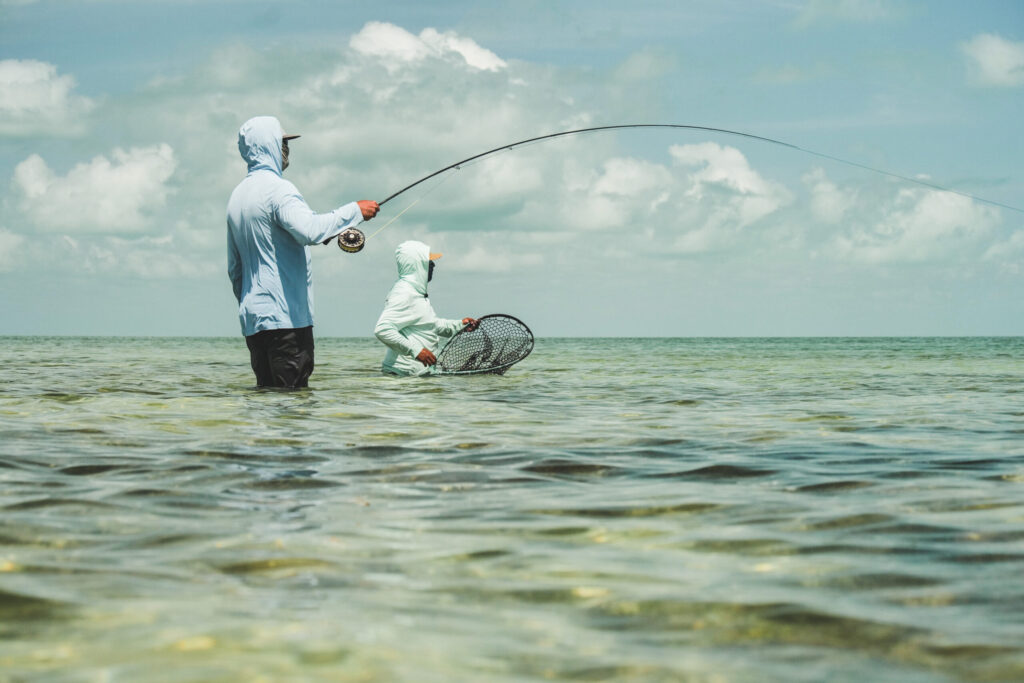
You’ve booked your trip to Xcalak or are planning to. So now you’re trying to figure out what you can get ready for. First, get into the mindset that fishing here will be different from the streams of the Rockies or the marshes of the East Coast.
One of the things that makes Xcalak such a great spot to fish is the flats. When it comes to fishing on the flats, you gotta be able to spot them. Spotting fish on the flats is one of the most critical (and most challenging) skills for any angler to learn.
If you’re new to flats fishing, don’t worry, it’s something anyone can get better at with the right approach, a bit of patience, and some local knowledge. Here are some tips to help you spot more fish in Xcalak’s crystal clear flats!
Understand What You’re Looking For
In Xcalak’s flats, fish like bonefish and permit are perfectly camouflaged. They often appear as dark or moving shapes against the sandy bottom or grassy patches. Unlike freshwater trout that may rise to sip a dry fly, flats fish rarely give away their presence with surface activity. Instead, you’ll be looking for subtle movement tails breaking the surface, nervous water (tiny ripples or wakes from swimming fish), or the flash of a side as they turn.
One key piece of advice: you’re often looking through the water, not at the surface. Train your eyes to scan below, adjust your focus, and stay patient.
Use the Sun to Your Advantage
Light is everything in flats fishing. The best visibility comes with the sun high in the sky, typically between 10 a.m. and 2 p.m. The more overhead and behind you the sun is, the better your ability to see into the water. Clouds can shut things down fast, so if the forecast calls for clear skies, plan your prime sight-fishing hours accordingly.
Also, don’t forget polarized sunglasses, they’re not optional gear. A quality pair in copper or amber lens color will reduce glare and help distinguish fish from their surroundings.
Learn the Water’s Color and Texture
When scanning the flats, don’t just look for fish, look for irregularities. In sandy areas, fish often appear as dark shadows moving slowly or sitting still. In grassy flats or turtle grass beds, they may appear as lighter blurs passing over a darker bottom.
“Nervous water” is another telltale sign. This is when fish disturb the surface subtly just enough to create shimmer or directional ripples. On calm days, spotting these disturbances can lead you right to a tailing permit or cruising snook.
Keep Movement to a Minimum
Beginners often make the mistake of shifting their position or rod too much while scanning. Sudden movements, even from a casting platform or panga, can spook fish. Try to stay still and move only your eyes or head slowly as you scan from near to far.
Your Xcalak fishing guide will often be on the poling platform helping you spot fish, so listen closely. When they say, “ten o’clock, 40 feet,” imagine a clock face where the bow of the boat is noon and cast accordingly.
Practice, Then Practice Some More
Like any skill, spotting fish on the flats improves with repetition. Xcalak is a perfect classroom with low fishing pressure, clear Caribbean water, and a variety of fish species. Start each morning by simply spotting more fish, not catching them. The more you do this, the quicker your eyes and brain will adapt to reading the water in Xcalak.
Get ready.
Flats fishing in Xcalak is a visual and tactical game, part hunting and part angling. It’s tough fishing, but you can beat the feeling when you spot a shadow 60 feet out, make the cast, and watch a bonefish eat if you’re planning a trip to this remote paradise and taking the time to hone your spotting skills. It’ll make every day on the water more successful and far more fun.
Whether you’re wading the edges of the bay or standing on one of our boats, keep your eyes peeled, stay calm, and enjoy the hunt. The fish are out there; you just have to spot them first.
Ready to experience world-class flats fishing in Xcalak? Book your fly fishing adventure with Xcalak On The Fly and let our expert guides help you make every cast count.

